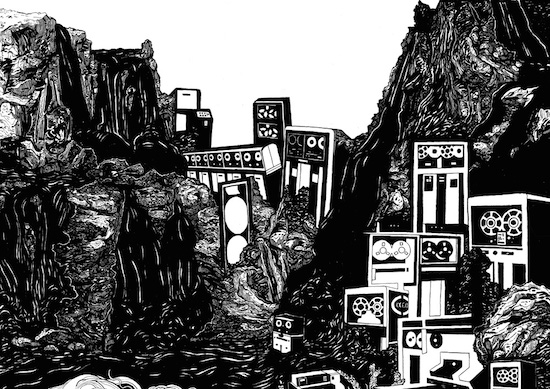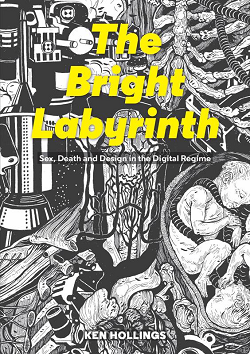On the factory Floor with John Cage and Edgard Varèse
Selected excerpts from The Bright Labyrinth: Sex, Death and Design in the Digital Regime by Ken Hollings (Strange Attractor Press)
The Bright Labyrinth, the latest book by Ken Hollings looks at the long shadows thrown in today’s digital regime by the culture and technology of the past. In the architecture, cinema and music of yesterday lie some of the clues on how to navigate our way out of the labyrinths of today. Key figures in this forward-looking history are Thomas Edison, inventor of the phonograph, and the composer Richard Wagner, both of whom were instrumental in shaping our experience of music. Add John Cage and Erik Satie to the mix, and things start to get…interesting.
In a West Orange factory entirely dedicated to the mass production of Edison’s Talking Dolls, organized teams of young women shout nursery rhymes into tiny phonographs while huge presses stamp out resonating metal bodies. The Edison Talking Doll is released in 1890 and then quickly pulled off the market. With the first cylinder phonograph intended for home use mounted inside her chest, the metal and porcelain figure is able, at the turn of a handle, to repeat the selected nursery rhymes or even wish its owner a ‘Happy Christmas’. The doll is an utter failure: most of them returned by disturbed customers. Even Edison has to admit that ‘the voices of the little monsters were exceedingly unpleasant to hear’.
We’ve had quite ENOUGH machine/machine/machine/machine
— El Lissitzky
‘One of the greatest assets that electronics has added to musical composition is that of metrical simultaneity,’ Varèse declares in a public lecture. ‘My music being based on movements of unrelated sound masses, I have long felt the need and anticipated the effects of having them move simultaneously at different speeds.’ Simultaneity, the most forceful celebration of the instantaneous, has preoccupied the avant-garde since the beginning of the twentieth century. In the age of Eli Witney and Henry Ford, the industrialization of culture inevitably arises from the measurement of work and leisure. George Antheil’s ‘first major work’ is scored for percussion and ‘countless numbers of player pianos’ to accompany Léger’s 1924 movie Ballet Mécanique. The composer’s rhythms reach across Léger’s edited images; continuity is established through tempo and repetition. Antheil describes the piece as ‘All percussive. Like machines. All efficiency. No LOVE. Written without sympathy. Written cold as an army operates. Revolutionary as nothing has been revolutionary.’ Except that the mechanical player pianos, in their cold efficiency, refuse to stay in synch with each other, and human pianists are required for the realization of a score conceived and composed ‘without sympathy’.
Metrical simultaneity, as Varèse conceives it, organizes sound into coordinated sequences. His three-track realization of Poème électronique commissioned by Dutch electronics firm Philips and recorded at its National Research Laboratory for playback at the Brussels World’s Fair in 1958 requires nine separate tape machines operating together in unison. Their playback speeds are kept as smooth and constant as humanly possible. To be out of synch also means to be out of tune. More significant than the gongs and other exotic percussion on display in Varèse’s studio after the composer’s death is the array of stopwatches on his desk. To lock music into a timetable of specific events requires the most careful synchronization. Two short works recorded by Greek composer Iannis Xenakis cover the time it takes to reset the equipment between one performance of Poème électronique at the Philips Pavilion and the next.

Whenever logical processes of thought are employed – that is, whenever thought for a time runs along an accepted groove – there is an opportunity for the machine.
— Vannevar Bush, ‘As We May Think’
One thing humans generally do better than machines is – adjust. Recorded music can therefore run wild among its listeners: concealed by their responses, its effects remain largely unseen. The introduction of magnetic tape establishes time as a plastic entity to be measured and cut, spliced together into new sequences and run at different speeds. Halfway between a mechanical device and an electronic medium, the tape recorder works as a model for explaining the operation of consciousness in time precisely because it has already altered the relationship between both to a profound degree. We exist purely in recorded time, which is also the regime of recorded music, and have no choice but to behave accordingly.
As chance will have it, American composer John Cage is also at the Brussels World’s Fair in 1958 to present a talk entitled, ‘Indeterminacy: New Aspects of Form in Instrumental and Electronic Music’. The lecture is made up of thirty written anecdotes read aloud by Cage so that each will fit exactly into one minute of elapsed time: the more words there are in each story, the quicker his delivery becomes. Apart from this one measure, nothing connects any of the individual anecdotes, either to each other each or to the stated theme of the talk. By using the number of words to determine tempo, Cage is seeking to demonstrate an organizational principle with regard to ‘new aspects of form’. The electronic poem created for the Philips Pavilion exploits the tension between music and text; the ‘metrical simultaneity’ Varèse speaks of is timetabled through the simple expedient of being inscribed onto magnetic tape. For Cage, however, text is regulated by time to become music.
All art aspires to the condition of the music in its wish to endure constant repetition. Repetition pulls the moment inside out. Repetition makes meaning total: which is to say, reduced to zero. Repetition is metrical simultaneity folded back upon itself. ‘Record’ and ‘Playback’ constitute a formula that can be endlessly repeated. Its fullest expression is the tape-loop. This continuous acetate band elevates sound reproduction into a new form of production: tones, pitches, rhythms and tempi can all be metrically derived from it. By transforming composition into a process, however, magnetic tape no longer allows for variations of interpretation in the manner of a conventional score. Other methods of notation are required. ‘Shall consider further use unfriendly,’ Varèse writes to Cage in 1940 after the latter publicly referred to his own music as ‘organized sound’. The term belongs exclusively to Varèse, the telegram asserts: metrical simultaneity would be unthinkable without it. Cage’s response is to separate simultaneity from synchronization and to treat music as organized activity instead.
Once synchronization is no longer a vital concern, the compositional process becomes a machine for generating individual events or sets of actions. Music transforms itself fully into a model for human behaviour: a temporary Utopia in the making. Created in 1965, Cage’s Rozart Mix is a work for ‘at least 4 performers with at least 12 tape recorders and at least 88 tape-loops’, and the score little more than notes exchanged between the composer and Alvin Lucier on the preparation of the loops. The content of each tape-loop is, in every sense of the word, immaterial compared with the independent frequency of its repetition in relation to the others, the state of the machine playing it back and its location in the room. The catalogue describes the piece’s duration as ‘indeterminate (about 2 hours during first performance)’; and the first live realization lasts as long as there is an audience to hear it. The free play of multiple tape-loops in Rozart Mix extends the event indefinitely – or at least until the last listener has left the room.
To be withheld upon any account, must be a vexation, but to be withheld by a vexation – must certainly be what philosophy justly calls
upon
VEXATION
— Laurence Sterne, The Life and Opinions of Tristram Shandy, Gentleman
‘Beethoven was in error,’ John Cage declares in a lecture delivered at Black Mountain College during the summer of 1948, ‘and his influence, which has been as extensive as it is lamentable, has been deadening to the art of music.’ This verdict, the cause of no little friction between Cage and the college faculty, concerns a fundamental question of structure. ‘With Beethoven the parts of a composition were defined by harmony,’ Cage argues. ‘With Satie and Webern they were defined by means of time lengths.’ Composition conceived purely in terms of duration exposes recorded music as mere data storage. At best, recorded music can only offer consolation for missed experience. The mechanical reproduction of sound also ensures that Beethoven’s harmony is transformed into that of bodies and machines working together. Duration withholds itself from such synchronization, becoming cumulative in its effects. With duration there are only beginnings and endings. No single event is more important than any other.
Cage makes his disparaging comments about Beethoven during a short summer-school celebration of the life and works of Erik Satie. Also present is Buckminster Fuller, who takes time out from his first attempt to construct a geodesic dome with some Black Mountain architecture students to play the lead in Satie’s music drama La Piége de Meduse. The same unadorned simplicity and modulated uniformity that inform the structure of Fuller’s geodesic dome can also be found in Satie’s later work, in which a hollowed-out aesthetic of monotony, almost mathematical in its regularity, is worked through. Cage later sees Satie’s notebooks in Paris and is excited to discover clusters of numbers in the margins, which he assumes were used to work out the rhythmical structuring of duration. ‘Oh no,’ assures the composer Darius Milhaud, who had known Satie personally. ‘Those numbers referred to shopping lists.’ Even so, the year following the summer celebrations at Black Mountain College, the score for Erik Satie’s Vexations is discovered and published for the first time. Composed in 1893, the score contains a short musical phrase, barely 80 seconds long, plus the instruction: ‘To be played 840 times’. Taking over eighteen hours to perform, Vexations is a music that loses itself in repetition. In the age of mechanical reproduction, it defies Edison’s phonograph to even register its full effect. Unlike Wagner’s ‘never-ending melody’, whose endless chord progressions appear to lead nowhere, Vexations repeatedly returns to its own starting point. In its simple juxtaposition of musical and textual notation, the score represents the emergence not of a new music but a new consciousness.
Like Cage’s ‘Indeterminacy’ lecture, Vexations addresses the process by which we adapt ourselves to the inflexibility of the machine. The process itself becomes the machine; and the piano in turn is transformed into an early precursor of the tape-loop. Composition defined in terms of duration invites chance to come into play through the suspension of individual will and preference by creating strategies specifically designed to frustrate them. Duration encourages the withholding of the individual self from the event. In 1963, exactly 70 years after Satie composed Vexations, Cage helps to organize its first public performance in a Greenwich Village theatre. A small assembly line of pianists is on hand to take over from one another in order that each of the 840 repetitions forms part of a continuous stream. As if to acknowledge that music is no longer a medium through which the relationship between audience and performer is subjected to metrical synchronization, Cage installs a factory clock in the venue’s lobby. Having paid a $5.00 admission fee, members of the public can punch in and out of the event, receiving a nickel refund for every twenty minutes spent listening to the piece. One individual brings a toothbrush and stays for the whole weekend. ‘After it was over,’ Cage later recalls, ‘I drove back to the country and I slept a long time, something like twelve hours. When I got up, the world looked new, absolutely new.’
Ken Hollings
February 2015

The Bright Labyrinth is out now, published by Strange Attractor


